View in other NatureServe Network Field Guides
NatureServe
Montana
Utah
Wyoming
Idaho
Wisconsin
British Columbia
South Carolina
Yukon
California
New York
Prairie Violet - Viola pedatifida
Other Names:
Larkspur-violet
State Rank Reason (see State Rank above)
Viola pedatifida was first documented in 2009 from southeast Montana (Hallman 2012). With a known distribution in the Great Plains of Canada and the United States (U.S.) and in portions of the southwest and midwest U.S., it had been 'reported' for Montana since 1966 (Booth 1966; Dorn 1984; and McGregor et al. [eds.] 1986). Its presence is known from a few locations where populations are small and widely separated. Additional surveys and monitoring are needed to map sites and assess population sizes and trends, threats, and habitat requirements.
- Details on Status Ranking and Review
Range Extent
ScoreC - 250-1,000 sq km (~100-400 sq mi)
Comment284 square kilometers.
Area of Occupancy
ScoreA - 1 4-km2 grid cell
CommentMontana can be divided into 30,390 4x4 square kilometer cells. For this species plant observations occur in 3 of these 4x4 square kilometer cells.
Number of Populations
ScoreA - 1 - 5
Comment3 observations representing 3 distinct locations.
General Description
PLANTS: Perennial herbs that lack a central stem (acaulescent) where the flower peduncle and leaf petiole grow directly from a thick, fleshy rhizome. Plants are 5-30 cm tall. Source: Little in Flora of North America [FNA] 2015.
LEAVES: Basal, 2-11 in number, with petioles, and are ascending to erect. Petioles are 3-16 cm and hairy (pubescent). Blades are deeply dissected with 5-9 lobes and ciliate, smooth (entire) margins. Surfaces are pubescent, though sometimes only on the veins. Lobes vary in shape - lanceolate, spatulate, falcate, or linear, 1-7cm wide by 2-8 cm long. Base of the blade is truncate to reniform. Apex of the blade is acute to obtuse. Stipules are linear lanceolate with entire margins and an acute apex. Source: Little in FNA 2015.
INFLORESCENCE: A single, violet flower that is scapose and arises from a rhizome. Peduncles are 5-18 cm long, glabrous or pubescent. Sepals are 5 in number, separate, mostly 6-8 mm long, usually ciliate, and lanceolate to ovate in shape with 1-2 mm long auricles. Petals are 5 in number, separate, 10-20 mm long, and violet or reddish-violet. The upper 2 petals are erect, less strongly dark veined, and usually bearded. The lower 3 petals spread and are white at their base with dark violet veins; the lowest petal is bearded, 10-25 mm long. The sac-like spur is colored the same as the petals, swollen on one side (gibbous), and 2-3 mm long. Fruit is a capsule. Sources: McGregor et al. [eds.] 1986; Little in FNA 2015.
Viola is the Latin name for the plant, derived from the Greek word ion for 'violet' (Little in FNA 2015; Giblin et al. [eds.] 2018).
Phenology
Flowering from March through June (Little in FNA 2015).
Diagnostic Characteristics
Viola species exhibit great phenotypic variation. Leaf and stem sizes usually increase a lot between early spring and late summer (Little in FNA 2015). Stem, leaf, and flower sizes vary with environmental factors, such as aspect, light, soil moisture, and other soil properties (Little in FNA 2015). The depth of the lobes can be dependent upon the age of the plant (Little in FNA 2015). Hybridization among the blue-flowered, acaulescent Violets in eastern North America is well documented (Little in FNA 2015).
Prairie Violet - Viola pedatifida
Separated by having this combination of characteristics:
*Petioles-Peduncles: Peduncles about equal to or usually longer than the leaves (petiole and blade);
*Leaves: Deeply lobed with lobes being similar in width and shape;
*Flowers: Cleistogamous flowers are present;
*Style: Beardless; and
*Petals: Lateral petals are bearded and sometimes the lowest one.
Species Range
Montana Range
Range Descriptions
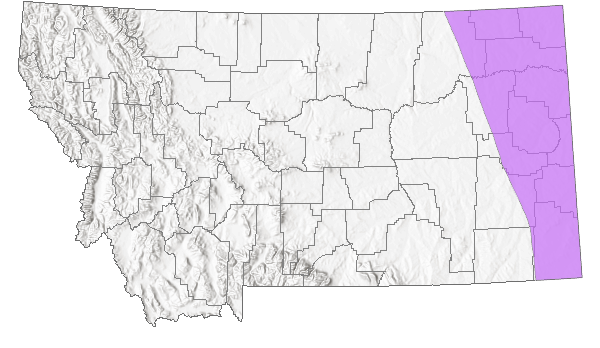
 Native
Native
Range Comments
Alberta to Ontario in Canada south to Montana, Wyoming, Colorado, and Arizona east to New Mexico, Oklahoma, Missouri, Illinois, Indiana, Ohio, and Michigan; also, in Virginia (Little in FNA 2015).
Observations in Montana Natural Heritage Program Database
Number of Observations: 13
(Click on the following maps and charts to see full sized version)
Map Help and Descriptions
Relative Density
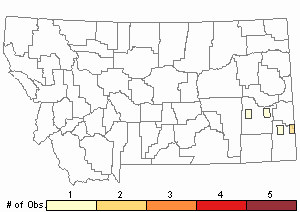
Recency
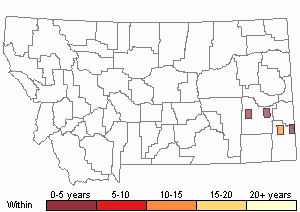

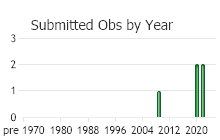
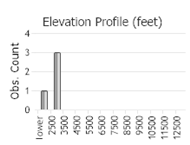 (Observations spanning multiple months or years are excluded from time charts)
(Observations spanning multiple months or years are excluded from time charts)
Habitat
Prairies, grasslands, disturbed ground, and gravelly hills from 500 to 1,000 meters in elevation (Little in FNA 2015).
National Vegetation Classification System Groups Associated with this Species
Grassland
Lowland - Prairie Grassland
Ecology
POLLINATORSPollinators to Violets (
Viola spp.) are rewarded with nectar and pollen and include bumblebees, honeybees, solitary bees, syrphid flies, butterflies, skippers, hawkmoths, moths, and beeflies (Little
in FNA 2015). The following
Bombus species have been reported as pollinators of this plant species or its genus where their geographic ranges overlap:
Bombus vagans,
Bombus pensylvanicus,
Bombus bimaculatus,
Bombus griseocollis, and
Bombus impatiens (Colla and Dumesh 2010, Williams et al. 2014). Thrips (Order Thysanoptera), aphids, and other tiny insects with pollen on their bodies have been observed in the flowers of Violets and potentially could affect pollination (Little
in FNA 2015).
Reproductive Characteristics
Plants reproduce from seeds and rhizomes.
FLOWERS [Adapted from Lesica et al. 2012; Little in FNA 2015]
Stamens are 5. Pistil has 1 style that is beardless and longer than the stamens. Ovary is superior.
Flowers are cleistogamous, which means they self-pollinate and set a fertile seed without the flower opening. Some acaulescent, blue-flowered Violet species develop their cleistogamous flowers beneath the soil surface or in the duff and arise on peduncles as they mature.
FRUITS [Adapted from Little in FNA 2015]
Capsules are 10-15 mm long, ellipsoid, glabrous, and yellow-green. Seeds are beige, mottled to bronze, usually arillate with elaiosome, and 1.5-2.5 mm long.
SEED DISPERSAL [Adapted from Little in FNA 2015]
Violets have capsules that split into three valves, which are usually thick in perennial species such as Prairie Violet, and thin in annual species. Some species have capsules that open relatively slowly to expose the seeds. Other species have capsules that as they dry will cause the valves to contract and squeeze the seeds which ejects them. Violet species that have downward pointing capsules passively release seeds while those on erect peduncles ballisticly disperse seeds.
Some species disperse their cleistogamous seeds into the soil or duff.
Most Violet species have a fleshy appendage or covering (aril) on the seed that is oil-rich (elaiosome), which is attractive to ants; thus, seeds are dispersed by ants (myrmecochory).
Stewardship Responsibility
Threats or Limiting Factors
In Montana intrinsic threats include small populations that are widely scattered.
STATE THREAT SCORE REASON
A State Threat Score is not assigned because the scope, severity, and/or timing of threats have not been documented (MTNHP Threat Assessment 2021).
References
- Literature Cited AboveLegend:
 View Online Publication
View Online Publication Booth, W. E. and J. C. Wright. 1966. Flora of Montana-Part II: dicotyledons. Montana State University, Bozeman, MT. 305 pp.
Booth, W. E. and J. C. Wright. 1966. Flora of Montana-Part II: dicotyledons. Montana State University, Bozeman, MT. 305 pp. Colla, S.R. and S. Dumesh. 2010. The bumble bees of southern Ontario: notes on natural history and distribution. Journal of the Entomological Society of Ontario 141:39-68.
Colla, S.R. and S. Dumesh. 2010. The bumble bees of southern Ontario: notes on natural history and distribution. Journal of the Entomological Society of Ontario 141:39-68. Dorn, R. D. 1984. Vascular Plants of Montana. Cheyenne, WY: Mountain West Publishing. 276 pp.
Dorn, R. D. 1984. Vascular Plants of Montana. Cheyenne, WY: Mountain West Publishing. 276 pp. Flora of North America Editorial Committee, eds. 2015. Flora of North America north of Mexico, Volume 6. Magnoliophyta: Cucurbitaceae to Droseraceae. Oxford University Press, Inc. New York.
Flora of North America Editorial Committee, eds. 2015. Flora of North America north of Mexico, Volume 6. Magnoliophyta: Cucurbitaceae to Droseraceae. Oxford University Press, Inc. New York. Hallman, Hansel J. 2012. Final Report to the United States Forest Service, Floristic Inventory of the Custer National Forest, Ashland and Sioux Ranger Districts. Department of Botany, University of Wyoming, Laramie, Wyoming.
Hallman, Hansel J. 2012. Final Report to the United States Forest Service, Floristic Inventory of the Custer National Forest, Ashland and Sioux Ranger Districts. Department of Botany, University of Wyoming, Laramie, Wyoming. Lesica, P., M.T. Lavin, and P.F. Stickney. 2012. Manual of Montana Vascular Plants. Fort Worth, TX: BRIT Press. viii + 771 p.
Lesica, P., M.T. Lavin, and P.F. Stickney. 2012. Manual of Montana Vascular Plants. Fort Worth, TX: BRIT Press. viii + 771 p. McGregor, R.L. (coordinator), T.M. Barkley, R.E. Brooks, and E.K. Schofield (eds). 1986. Flora of the Great Plains: Great Plains Flora Association. Lawrence, KS: Univ. Press Kansas. 1392 pp.
McGregor, R.L. (coordinator), T.M. Barkley, R.E. Brooks, and E.K. Schofield (eds). 1986. Flora of the Great Plains: Great Plains Flora Association. Lawrence, KS: Univ. Press Kansas. 1392 pp. MTNHP Threat Assessment. 2021. State Threat Score Assignment and Assessment of Reported Threats from 2006 to 2021 for State-listed Vascular Plants. Botany Program, Montana Natural Heritage Program, Helena, Montana.
MTNHP Threat Assessment. 2021. State Threat Score Assignment and Assessment of Reported Threats from 2006 to 2021 for State-listed Vascular Plants. Botany Program, Montana Natural Heritage Program, Helena, Montana. Williams, P., R. Thorp, L. Richardson, and S. Colla. 2014. Bumble Bees of North America. Princeton, NJ: Princeton University Press. 208 p.
Williams, P., R. Thorp, L. Richardson, and S. Colla. 2014. Bumble Bees of North America. Princeton, NJ: Princeton University Press. 208 p.
- Additional ReferencesLegend:
 View Online Publication
View Online Publication
Do you know of a citation we're missing? Lesica, P., M.T. Lavin, and P.F. Stickney. 2022. Manual of Montana Vascular Plants, Second Edition. Fort Worth, TX: BRIT Press. viii + 779 p.
Lesica, P., M.T. Lavin, and P.F. Stickney. 2022. Manual of Montana Vascular Plants, Second Edition. Fort Worth, TX: BRIT Press. viii + 779 p.
- Web Search Engines for Articles on "Prairie Violet"





